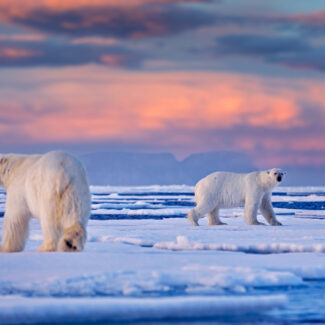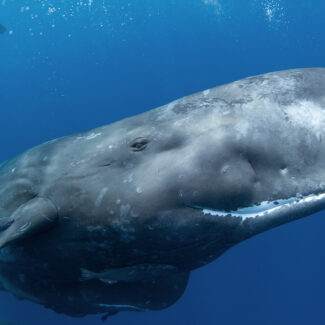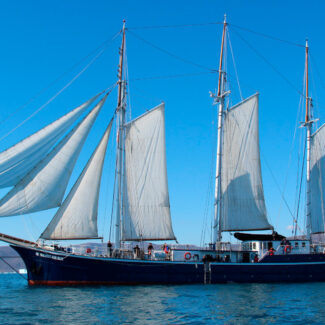A Giant Hole In Antarctica? That'll Be A Polynya
The phrase “hole in Antarctica” might spark a few different lines of thought. You might imagine, for example, that the Antarctica hole in question refers to the infamous ozone hole, the depletion of the ozone layer in the Earth’s stratosphere over the South Pole observed in the 1980s and ‘90s that led to the phaseout of ozone-destroying chlorofluorocarbons.
Aficionados of polar history or “Hollow Earth” conspiracy theories might find themselves thinking about the “hole in the Pole” Admiral Richard Byrd is alleged (without evidence) to have discovered—one of more than a few zany ideas floating around the popular consciousness concerning the White Continent.
Is there a hole in Antarctica? Well, there may not be a portal into some hidden subterranean realm at the center of the Earth, but there are most definitely numerous fascinating holes of a different kind: large—sometimes even gigantic—gaps in the Antarctic sea ice that have long fascinated scientists.
Introducing the Hole in Antarctica Ice: The Polynya
The holes that open in the sea ice of Antarctica and the Southern Ocean are known as polynyas, adapted from a Russian word. They may range from a few hundred meters to several hundred kilometers across.
Polynyas are somewhat similar to the openings in sea ice known as leads. Those, however, tend to be linear and short-lived features, while polynyas are usually broader and more oval or irregular in shape, and often remain unfrozen for comparatively long periods of time. Leads form due to movement and stress within the pack ice, while polynyas come about via different mechanisms (which we’ll dig into shortly).
Two main types of polynyas exist in Antarctica, differentiated by the manner by which ice is removed to create them: coastal and open-ocean polynyas. The former have long been known, while it took until the 1970s, with the development of modern satellite technology, for scientists to document the open-ocean variety.
Coastal Polynyas
As the name suggests, coastal polynyas are generally found along the Antarctic shoreline (including the shoreline created by an ice shelf such as the Ross Ice Shelf). The largest may form a gap of dozens of miles between fast (coast-attached) ice and the landward margin of the ice pack.
The primary persistent coastal polynyas develop as strong winds off the White Continent—the sometimes downright fearsome katabatic winds—blow away freshly formed sea ice. More variable local winds can also open up ephemeral polynyas that exist more fleetingly.
Coastal polynyas are also known as latent-heat polynyas, on account of the form of heat—heat associated with a change in state of matter—which they release as new sea ice forms and water evaporates from their surface.
It’s important to note that latent-heat polynyas can technically appear away from the coast. Winds blowing over and around the barrier of an iceberg grounded in the pack ice, for example, can push ice away from the leeward side of the berg to open up a polynya that then functions similarly to one created along the shoreline.
Open-Ocean Polynyas
Antarctica’s open-ocean polynyas, also known as mid-sea polynyas or sensible-heat polynyas, form well offshore in the midst of the Southern Ocean’s wintertime pack ice. The two best-known examples are the Weddell or Maud Rise Polynya, which has been observed periodically in the Weddell Sea pack near the Maud Rise Seamount, and a smaller polynya that recurs in the Cosmonaut Sea.
Initially documented in 1974-1976 and then again in 2016, 2017, and 2019, the Weddell Polynya can be of whopping size: In the mid-1970s, one incarnation measured some 218 by 621 miles (~350 by 1,000 kilometers) across. Its 2010s manifestation didn’t quite attain such dimensions, but this was still one heck of a hole in the ice: In September and October of 2017, the Weddell Polynya’s area was roughly 19,000 square miles (50,000 square kilometers).
Scientists are still learning about the intricacies of ocean-atmosphere processes that promote the formation of open-ocean polynyas, but the primary cause is thought to be convective upwelling of warm water to the surface, which melts overlying sea ice and opens the hole. (The direct heat transfer involved explains that alternative name of open-ocean polynyas: sensible-heat polynyas.)
Such upwellings may be due to features of submarine topography or to overturning of oceanic circulation, which may (as research into the 2016-2017 Weddell Polynya suggested) sometimes be spurred by the strong winds of large cyclonic storms in the Southern Ocean.
Significance of Antarctic Polynyas
While there’s still a great deal we don’t know about them, it’s safe to say that polynyas have a profound and far-reaching effect on the Antarctic environment—and even beyond.
Coastal polynyas have been called “sea-ice factories,” because they continually form new sea ice that’s then blown away by the polynya-creating winds, exposing surface water to begin the freezing process anew.
As this freezing process occurs, salt is expelled from the developing ice, increasing the salinity—and therefore the density—of the surrounding waters. This saltier, denser water produced in the coastal polynya sinks to help generate the Antarctic Bottom Water that helps drive global oceanic circulation.
Both coastal and open-ocean polynyas contribute moisture and heat to the atmosphere, and are thought to play a critical role in the cycling of carbon.
The open water exposed to sunlight and air makes polynyas oases of high productivity within the Antarctic sea ice, fueling phytoplankton blooms and offering rich foraging ground for seals, penguins, and other marine life. Access to polynyas is thought to be a critical survival factor for certain penguin rookeries.
Who knew a hole in the ice could be so important?
Disclaimer
Our travel guides are for informational purposes only. While we aim to provide accurate and up-to-date information, Antarctica Cruises makes no representations as to the accuracy or completeness of any information in our guides or found by following any link on this site.
Antarctica Cruises cannot and will not accept responsibility for any omissions or inaccuracies, or for any consequences arising therefrom, including any losses, injuries, or damages resulting from the display or use of this information.










